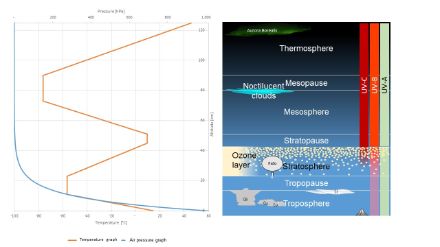Service Navigation
Search
The vertical structure of the atmosphere

Troposphere and tropopause
The troposphere is the lowest layer of our atmosphere. The solar radiation that reaches the Earth’s surface is absorbed, warming the planet. In turn, this warmth is transferred to the layer of air directly above the Earth’s surface. The heat reaches higher air layers through turbulent exchange and convection.
The air pressure decreases with altitude because there is an increasingly smaller air column above, exerting less pressure on the air parcel directly beneath it.
Temperature decreases with altitude
As a result, an ascending air parcel (rising by convection) expands due to the decreasing air pressure with increasing altitude. Energy is required for this expansion, which is drawn from the heat carried by the ascending air. The ascending and expanding air parcel (Temperature decrease with altitude) thus cools down. This explains the troposphere’s decreasing vertical temperature gradient.
The temperature decrease only continues as high as convection takes place. The troposphere is higher up (around 18 km) in warmer regions (around the Equator) than it is over the poles (around 13 km). The different seasons also affect the altitude of the troposphere.
Troposphere: the layer where most weather phenomena occur
The troposphere contains nearly all of the atmosphere’s total water content and about three-quarters of its total mass. Consequently, all of the weather processes that are governed by mass and water vapour take place within it, such as high- and low-pressure systems or cloud formation and precipitation. In other words, it is the layer in which most weather phenomena occur.
The tropopause marks the upper limit of the troposphere and the transition to the stratosphere. The tropospheric temperature decrease with altitude no longer applies here. The tropopause has an average temperature of around -56 degrees Celsius, ranging between -80 and -50 degrees Celsius depending on the region and season.